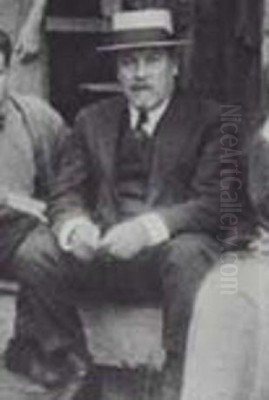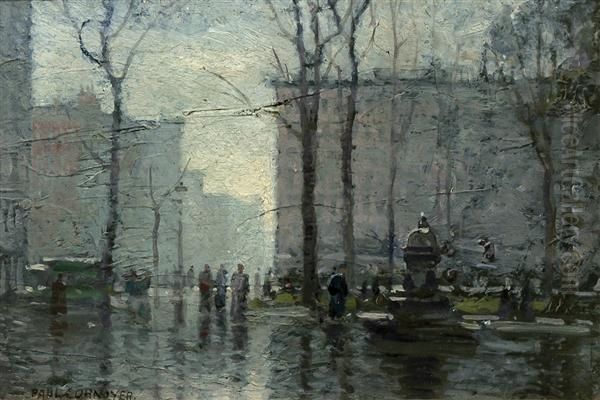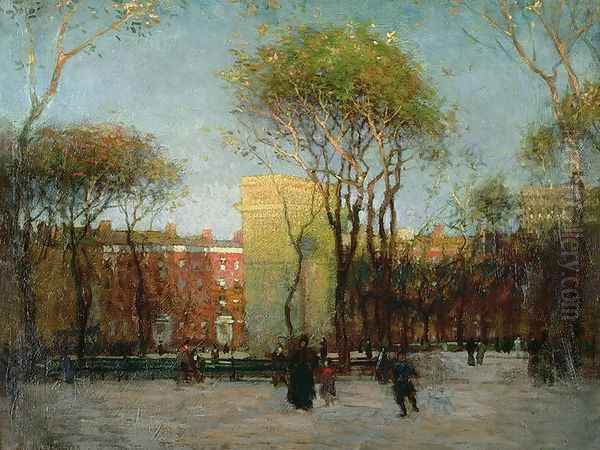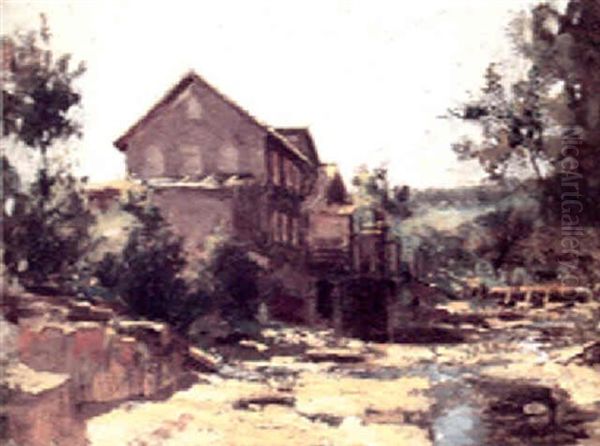
Paul Cornoyer (1864–1923) stands as a significant figure in American art history, celebrated primarily for his evocative depictions of New York City at the turn of the 20th century. An American painter by birth and trade, Cornoyer masterfully blended elements of Impressionism and Tonalism to capture the unique atmosphere and light of the urban landscape, particularly under the veil of rain, snow, or twilight. His work offers a poetic glimpse into the bustling, yet often moody, character of the city during a period of rapid transformation.
Early Life and Artistic Formation in St. Louis
Born in St. Louis, Missouri, in 1864, Paul Cornoyer's artistic journey began in his hometown. He enrolled in the St. Louis School of Fine Arts in 1881, where his initial training was rooted in the prevailing Barbizon style. This European-influenced movement emphasized realism, soft forms, and a subdued palette, often focusing on rural landscapes. Cornoyer absorbed these principles, and his early works reflected this sensibility. His talent was recognized early on, leading to his first public exhibition in 1887, marking the formal start of his career as a professional artist within the St. Louis art community.
Parisian Influence and Development
Seeking to broaden his artistic horizons, Cornoyer traveled to Paris in 1889, a pivotal move for his stylistic development. He enrolled at the prestigious Académie Julian, studying under respected academic painters such as Jules Joseph Lefebvre, Louis Blanc, and Jean-Joseph Benjamin-Constant. While these instructors provided a strong foundation in traditional techniques, it was the vibrant Parisian art scene, particularly the lingering influence of French Impressionism, that truly reshaped Cornoyer's vision.
He was exposed to the works of Impressionist masters like Claude Monet, Camille Pissarro, and Alfred Sisley, whose focus on capturing fleeting moments of light and color profoundly impacted him. During his time abroad, Cornoyer also traveled to London and Venice, further enriching his visual experiences. His work began to incorporate brighter palettes and looser brushwork, though often tempered by a Tonalist sensibility. His growing skill gained recognition, earning him a first prize from the Paris American Art Association in 1892.
Return to America and St. Louis Period

Cornoyer returned to St. Louis in 1894, bringing with him the influences of his European studies. His style began to mature, moving towards a more lyrical and atmospheric approach that blended Impressionistic light effects with the moody introspection of Tonalism. This period saw him undertake a significant commission: a mural for the Planters Hotel in St. Louis, completed in 1895. Titled the St. Louis Triptych, this work depicted the city's founding alongside its modern urban reality, showcasing his ability to handle large-scale compositions and historical themes.
His work during this time earned him further accolades, including a gold medal from the St. Louis Association of Painters and Sculptors in 1895. He became an active member of local art groups, including the Artists' Club, where he had previously won a first prize in 1892. Although successful in St. Louis, the allure of the nation's burgeoning art capital would soon draw him eastward. The Tonalist undercurrent in his work resonated with trends being explored by American artists like James McNeill Whistler and George Inness, who emphasized mood and atmosphere over precise detail.
The New York Years: A City Observed
The year 1899 marked another crucial turning point in Cornoyer's life and career. Impressed by one of Cornoyer's paintings (reportedly a Paris scene), the influential American Impressionist painter and teacher William Merritt Chase encouraged him to move to New York City. Cornoyer heeded the advice, relocating to the metropolis that would become the primary subject of his mature work. New York provided endless inspiration with its dynamic street life, iconic architecture, and ever-changing atmospheric conditions.
In New York, Cornoyer solidified his reputation as a specialist in urban landscapes, particularly Tonalist cityscapes. He became fascinated with capturing the city's mood under specific weather conditions – the slick sheen of rain-soaked streets, the soft diffusion of light during snowfall, the hazy glow of twilight, or the interplay of natural and artificial light after dark. His preferred locales often included well-known landmarks like Washington Square, Madison Square, and Central Park, but his focus was less on topographical accuracy and more on conveying the emotional essence of the scene.

His approach differed from some contemporaries who also depicted New York. While Ashcan School painters like John Sloan or Robert Henri (also a prominent teacher) often focused on the grittier, more socially charged aspects of urban life, Cornoyer's vision was generally more poetic and refined. His work shares some affinity with the urban Impressionism of Childe Hassam, another painter famous for his New York scenes, particularly flag-lined avenues. However, Cornoyer's style is often distinguished by its softer focus, more muted palette (though capable of Impressionist brightness), and a pervasive sense of quietude, even amidst the city's bustle. He found a unique niche, capturing the beauty in moments others might overlook.
Artistic Style: Impressionism Meets Tonalism
Paul Cornoyer's signature style is best characterized as a harmonious fusion of American Impressionism and Tonalism. From Impressionism, he adopted the interest in capturing the effects of light and atmosphere, often using broken brushwork and a sensitivity to color variations caused by changing light. He was particularly adept at rendering reflections on wet pavements and the diffused glow of streetlights through mist or rain.
However, his work rarely embraced the full, high-keyed palette of French Impressionism. Instead, he leaned towards the Tonalist emphasis on mood, subtlety, and a limited, harmonious range of colors. Tonalism, popular in America in the late 19th and early 20th centuries, favored evocative, atmospheric scenes over detailed representation. Cornoyer's paintings often possess this quiet, introspective quality, using subtle gradations of tone to create depth and emotional resonance. Some sources also note occasional use of Pointillist techniques – applying small dots of color – likely as another tool to achieve specific light effects, rather than a dominant stylistic feature.
This blend resulted in cityscapes that are both visually descriptive and deeply atmospheric. He captured the architectural forms and human activity of New York, but filtered through a lens of subjective feeling and poetic interpretation. His mastery lay in balancing the objective observation of the city with a lyrical, almost melancholic, mood, making his paintings uniquely appealing and enduring. His contemporaries in American Impressionism, such as J. Alden Weir or Theodore Robinson, often focused on rural landscapes or figurative work, further highlighting Cornoyer's distinct specialization in the urban scene rendered with this particular stylistic blend.
Major Works and Themes
Throughout his New York period, Cornoyer produced a body of work that consistently explored the interplay of light, weather, and urban architecture. Several paintings stand out as representative of his achievement:

The Plaza After Rain (also sometimes related to scenes titled Central Park at the Boat Pond or similar): This iconic work, acquired by the Saint Louis Art Museum in 1910, exemplifies his fascination with rainy cityscapes. It captures the reflective surfaces of wet ground, the diffused light, and the elegant movement of figures and carriages in a familiar New York setting, likely near Central Park.
Rainy Day in the City / Rainy Day, New York: Several works bear similar titles, highlighting this recurring and favorite theme. These paintings showcase his skill in depicting the muted colors, soft edges, and glistening reflections characteristic of a wet urban environment.
Washington Square: A frequent subject, Cornoyer painted Washington Square under various conditions, capturing the arch, the surrounding buildings, and the park's atmosphere, often emphasizing the effects of seasonal changes or specific times of day.
Madison Square, Rainy Night: This title suggests his interest extended to nocturnal scenes, where the challenge lay in capturing the interplay of darkness, artificial light (gas lamps or early electric lights), and weather effects, creating scenes of moody urban beauty.
A Spring Day, New York: While known for inclement weather, Cornoyer also depicted brighter moments. This work, which achieved a high auction price, likely showcased a more vibrant palette while retaining his characteristic atmospheric sensitivity.
Nightfall: Another title indicating his exploration of transitional times of day, capturing the unique light and mood as evening descends upon the city.
Common themes running through these works include the transient beauty of atmospheric effects, the rhythm of urban life (pedestrians, horse-drawn carriages, early automobiles), and the poetic potential of the modern cityscape. He found beauty not just in the grand monuments but in the everyday ambiance of New York's streets and squares.
Teaching and Professional Recognition
Beyond his own painting practice, Paul Cornoyer was also a respected educator. He taught art classes at the Mechanics' Institute in New York City, sharing his knowledge and techniques with aspiring artists. He also maintained a studio and likely taught during summers in the artists' colony of East Gloucester, Massachusetts, a popular destination for painters seeking coastal scenery, though Cornoyer remained primarily focused on his urban subjects.

His contributions to the art world were formally recognized by his peers. In 1909, he was elected an Associate Member of the National Academy of Design (ANA), a prestigious honor signifying his standing within the American art establishment. He remained an active participant in the art community, exhibiting his work regularly and maintaining memberships in organizations like the Salmagundi Club and the Allied Artists of America, in addition to his earlier affiliations in St. Louis. His role as both artist and teacher placed him firmly within the network of influential figures shaping American art in the early 20th century.
Market and Legacy
Paul Cornoyer's paintings were well-received during his lifetime and continue to be highly regarded and sought after in the art market today. His works are held in the permanent collections of major institutions, including the Metropolitan Museum of Art in New York, the Saint Louis Art Museum, the Brooklyn Museum, the Smithsonian American Art Museum, and numerous other public and private collections across the United States.
Auction records reflect sustained interest from collectors. While some smaller works or studies might sell for a few thousand dollars (like the $1,680 Paris scene mentioned), his prime New York cityscapes command significant prices. Works like Rainy Day, New York ($78,000 in 2012) and A Spring Day, New York ($96,000 in 2012) demonstrate the strong market value attached to his signature subjects and style. Estimates for works like Nightfall ($30,000-$50,000 in 2024) further confirm his status as a desirable artist. The price range for his work is broad, reflecting variations in size, subject matter, condition, and period, but the upper end clearly indicates his importance.
Cornoyer's legacy rests on his distinctive contribution to American Impressionism and Tonalism. He carved out a unique niche by applying these styles primarily to the urban landscape of New York City, capturing its atmosphere with unparalleled sensitivity. He demonstrated that the modern city, even in its more somber moments, could be a source of profound poetic beauty. While later artists like Edward Hopper would explore urban themes with a different, starker sensibility, Cornoyer's work remains a touchstone for the romantic, atmospheric depiction of city life at the turn of the century.
Conclusion

Paul Cornoyer was more than just a painter of city streets; he was a poet of urban atmosphere. Born in the Midwest, trained in the academic traditions of St. Louis and Paris, and ultimately finding his muse in the dynamic environment of New York City, he forged a unique artistic identity. By skillfully blending the light-filled techniques of Impressionism with the moody introspection of Tonalism, he captured the ephemeral beauty of New York under varying conditions of weather and light. His evocative paintings of rain-slicked avenues, snow-dusted squares, and twilight vistas continue to resonate with viewers, offering a timeless glimpse into the soul of a city through the eyes of a master observer. His work secures his place as a key figure in American painting, celebrated for his technical skill, his distinctive style, and his enduringly atmospheric portrayals of urban life.